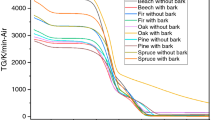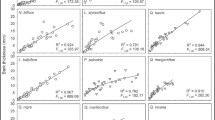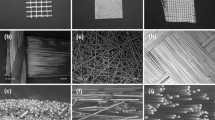Abstract
When exposed to a surface fire, the probability of a tree to survive widely varies, depending on its capability to protect the cambium from lethal temperatures above 60 °C. Thereby, the bark, the entirety of all tissues outside the cambium, serves as an insulation layer. In laboratory experiments, the heat production of a surface fire was simulated and the time span τ60 until the temperature of 60 °C is reached in the inner bark surface was measured. Thereby, τ60—as a measure of the fire resistance—was quantitatively determined for seven tree species. In addition, the influence of bark thickness and moisture content on bark heat insulation capacities was examined. Independent of the tree species and bark moisture content a power function correlation between bark thickness and τ60 was found. Our results also show that fire resistance increases with decreasing bark density. The seven tree species examined can be classified in two groups differing highly significant in their bark structure: (1) tree species with a faintly structured bark, which show a low fire resistance, and (2) tree species with an intensely structured bark, showing a high fire resistance. Furthermore a mathematical model simulating heat conduction was applied to describe the experimental results, and some ideas for a transfer into biomimetic materials are presented.











Similar content being viewed by others
References
Goldammer JG (1994) In: Feuer in der Umwelt: Ursachen und ökologische Auswirkungen von Vegetationsbränden; Konsequenzen für Atmosphäre und Klima; Arbeitsbericht 1992–1994/Arbeitsgruppe Feuerökologie und Biomasseverbrennung, Max-Planck-Institut für Chemie, Abteilung Biogeochemie, Freiburg, p 3
Goldammer JG (1998) In: Proceedings, first baltic conference on forest fires, Radom-Katowice, Poland, p 59
Richter M (1997) Allgemeine Pflanzengeographie. Teubner, Stuttgart
Prakash A, Gupta RP (1999) Int J Remote Sens 20:1935
Van Mantgem P, Schwartz M (2003) For Ecol Manag 178:341
Dimitri L (1968) Holz Roh Werkst 26(3):95
Hare RC (1965) J For 63(4):248
Hengst GE, Dawson JO (1994) Can J For Res 24(4):688
Pinard MA, Huffman J (1997) J Trop Ecol 13:727
Gill AM, Ashton DH (1968) Aust J Bot 16:491
Martin RE (1963) For Prod J 13:419
Uhl C, Kauffman JB (1990) Ecology 71(2):437
Harmon ME (1984) Ecology 65(3):769
Vines RG (1968) Aust J Bot 16(3):499
Grammel R (1989) Forstbenutzung. Verlag Paul Parey, Hamburg und Berlin
Simpson W, TenWolde A (1999) In: Wood handbook—wood as an engineering material. General technical report FPL; GTR-113. Department of Agriculture, Forest Service, Madison, WI, US, p 3-1
Press WH, Teukolsky SA, Vetterling WT, Flannery BP (1992) Numerical recipes in FORTRAN, 2nd edn. Cambridge University Press, Cambridge
Carroll DL (2001) A genetic algorithm in Fortran Version 1.7a. www.cuaerospace.com. Accessed Oct 2009
Knigge W, Schulz H (1966) Grundriss der Forstbenutzung. Verlag Paul Parey, Hamburg und Berlin
Wade DD (1993) Int J Wildland Fire 3(3):169
Junikka L (1994) IAWA J 15(1):3
Fahnestock GR, Hare RC (1964) J For 62:779
Nicolai V (1989) Oecologia 80:421
Megraw RA (1976) US Patent 3,996,325
Hovey RW (1965) J Spacecr 2(3):300
Hare RC (1965) J For 63:248
Bauer G, Speck T, Liehr AW, Speck O (2009) In: Thibaut B (ed) Proceedings of the 6th plant biomechanics conference. French Guyana, France, ECOFOG Cayenne, p 482
Acknowledgements
We thank Julia Mergner for her assistance in examining bark density, and Rudolf Hog from the Garten- und Tiefbauamt Freiburg, as well as Wolfgang Lay, Dieter Rahm and Hans Bauer for providing plant material. We also thank Andreas Liehr for his support with the statistical analysis of the experimental data.
Author information
Authors and Affiliations
Corresponding author
Appendix
Appendix
See Table 2.
Rights and permissions
About this article
Cite this article
Bauer, G., Speck, T., Blömer, J. et al. Insulation capability of the bark of trees with different fire adaptation. J Mater Sci 45, 5950–5959 (2010). https://doi.org/10.1007/s10853-010-4680-4
Received:
Accepted:
Published:
Issue Date:
DOI: https://doi.org/10.1007/s10853-010-4680-4




